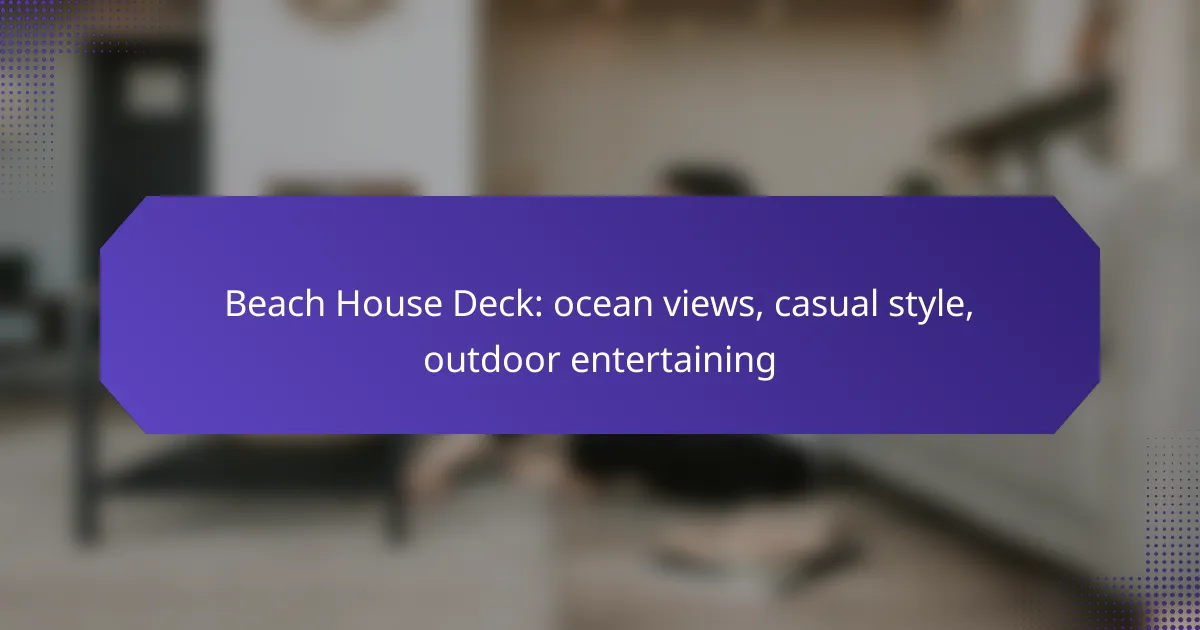Designing a beach house deck with stunning ocean views requires careful consideration of placement and materials to enhance both visibility and comfort. By choosing durable, stylish materials and focusing on a casual aesthetic, you can create an inviting space perfect for relaxation and outdoor entertaining. Emphasizing comfort and functionality will ensure your deck becomes a cherished gathering spot for family and friends.

How to design a beach house deck for ocean views?
Designing a beach house deck for ocean views involves strategic placement and materials that enhance visibility and comfort. Focus on elevation, transparency, and natural aesthetics to create an inviting space for relaxation and entertaining.
Maximize sightlines with elevated structures
Elevating your deck can significantly enhance ocean views by positioning you above any obstructions like dunes or vegetation. Consider building your deck at least 1-2 meters above ground level to achieve optimal sightlines. This elevation not only improves visibility but also adds a sense of spaciousness to your outdoor area.
When planning the height, ensure compliance with local building codes, which may dictate maximum heights or require permits. A well-placed elevated deck can become a stunning focal point for your beach house, offering panoramic views of the coastline.
Incorporate glass railings for unobstructed views
Glass railings are an excellent choice for beach house decks, providing safety without obstructing the view. Opt for tempered glass panels that are durable and can withstand coastal weather conditions. These railings create a seamless transition between the deck and the ocean, allowing for uninterrupted sightlines.
When installing glass railings, ensure they meet local safety regulations, which often require specific heights and structural integrity. Regular maintenance, such as cleaning and checking for cracks, will keep your railings looking pristine and functional.
Use natural materials for aesthetic harmony
Choosing natural materials like wood, stone, or composite decking can enhance the beach house’s connection to its surroundings. Look for weather-resistant woods such as teak or cedar, which can withstand the coastal environment while providing a warm, inviting look. Composite materials can also be a great option, offering durability with less maintenance.
Incorporate textures and colors that reflect the beach environment, such as sandy tones or ocean blues, to create a cohesive design. Avoid synthetic materials that may clash with the natural landscape, ensuring your deck complements the beauty of the ocean and sky.

What are the best materials for a beach house deck?
The best materials for a beach house deck combine durability, style, and low maintenance, essential for withstanding coastal conditions. Popular choices include composite decking, teak wood, and aluminum, each offering unique benefits suited for outdoor entertaining and enjoying ocean views.
Composite decking for durability
Composite decking is a blend of wood fibers and recycled plastic, making it highly resistant to moisture, fading, and insects. This material is ideal for beach house decks as it can withstand harsh weather conditions while requiring minimal upkeep.
When choosing composite decking, look for products with a high percentage of recycled content and a warranty of at least 25 years. Brands like Trex and TimberTech offer a variety of colors and textures that mimic natural wood, enhancing the casual style of your beach house.
Teak wood for classic style
Teak wood is renowned for its natural beauty and durability, making it a timeless choice for beach house decks. Its high oil content provides resistance to water and decay, ensuring longevity even in humid coastal environments.
While teak can be more expensive than other materials, its aesthetic appeal and comfort underfoot justify the investment. Regular maintenance, such as oiling and sealing, will help preserve its rich color and prevent weathering.
Aluminum for low maintenance
Aluminum decking is a lightweight, rust-resistant option that requires virtually no maintenance, making it perfect for beach houses. It can withstand extreme temperatures and is impervious to moisture, ensuring a long-lasting deck.
Available in various colors and finishes, aluminum decking can complement any coastal design. However, be mindful that it can get hot under direct sunlight, so consider adding shade elements or using lighter colors to mitigate heat absorption.

How to create a casual style on your deck?
To create a casual style on your deck, focus on comfort and functionality while embracing a relaxed aesthetic. This involves selecting the right furniture, incorporating lively textiles, and opting for informal dining arrangements that encourage outdoor entertaining.
Choose comfortable, weather-resistant furniture
Selecting comfortable, weather-resistant furniture is essential for a casual deck style. Look for pieces made from materials like teak, aluminum, or synthetic wicker, which can withstand the elements while providing comfort.
Consider lounge chairs, sectionals, and hammocks that invite relaxation. Aim for cushions with quick-drying foam and UV-resistant fabric to ensure durability and ease of maintenance.
Incorporate vibrant outdoor textiles
Vibrant outdoor textiles can enhance the casual feel of your deck. Use colorful throw pillows, outdoor rugs, and table linens to add personality and warmth to the space.
Choose fabrics that are fade-resistant and easy to clean, such as acrylic or polyester blends. Mixing patterns and colors can create a lively atmosphere, making your deck an inviting spot for gatherings.
Use informal dining setups
Informal dining setups are key to fostering a relaxed atmosphere on your deck. Opt for picnic tables, bistro sets, or even a casual buffet style for serving food.
Consider using melamine dishware and unbreakable glassware to keep things easygoing and safe. Arrange seating in a way that encourages conversation, such as using a mix of chairs and benches to create a communal feel.

What are effective outdoor entertaining ideas for beach house decks?
Effective outdoor entertaining ideas for beach house decks include creating inviting spaces that enhance social interaction and take advantage of stunning ocean views. Consider incorporating features like a bar area, a fire pit, and ambient lighting to elevate your gatherings.
Set up a bar area for cocktails
A dedicated bar area can transform your beach house deck into a lively social hub. Choose a location with a clear view of the ocean and install a bar cart or a built-in bar to serve drinks easily. Stock it with essentials like spirits, mixers, and garnishes to cater to various tastes.
Consider adding seating around the bar for guests to relax while enjoying their cocktails. A few bar stools or lounge chairs can create a casual atmosphere, encouraging conversation and interaction among guests.
Create a fire pit for evening gatherings
A fire pit provides warmth and a cozy ambiance for evening gatherings on your deck. Opt for a portable fire pit or a built-in option, ensuring it complies with local regulations regarding outdoor fires. Position it in a central location to allow for easy access and visibility.
Surround the fire pit with comfortable seating, such as Adirondack chairs or outdoor sofas, to invite guests to gather around. This setup not only enhances the atmosphere but also encourages storytelling and bonding under the stars.
Install outdoor lighting for ambiance
Outdoor lighting is crucial for creating a welcoming atmosphere on your beach house deck after sunset. String lights, lanterns, or solar-powered fixtures can add charm while providing adequate illumination for safety and enjoyment.
Consider layering different types of lighting, such as task lighting for the bar area and softer ambient lighting around seating areas. This combination helps set the mood and allows guests to enjoy the space comfortably during evening events.

What are the local regulations for building a deck in coastal areas?
Local regulations for building a deck in coastal areas often focus on safety, environmental protection, and community aesthetics. It’s essential to check specific guidelines in your area, as they can vary significantly based on location and local government policies.
Check zoning laws for height restrictions
Zoning laws dictate how tall your deck can be, especially in coastal areas where views and privacy are concerns. Typically, height restrictions may range from 10 to 15 feet above ground level, but this can vary by municipality.
To ensure compliance, consult your local zoning office or website for specific height limits and any additional requirements related to your property type.
Understand building permits required
Most coastal areas require a building permit before constructing a deck. This process usually involves submitting plans that detail the deck’s design, dimensions, and materials.
Permits can take several weeks to obtain, so it’s wise to start this process early. Fees may vary, but expect to pay anywhere from $50 to several hundred dollars depending on the project’s scale.
Review environmental impact assessments
Environmental impact assessments are often necessary for deck construction in coastal regions to evaluate potential effects on local ecosystems. These assessments help ensure that your deck does not harm wildlife habitats or coastal landscapes.
Be prepared to provide information about your project and possibly adjust your plans based on feedback from environmental agencies. This step can be time-consuming but is crucial for compliance with local and federal regulations.

How to maintain a beach house deck?
Maintaining a beach house deck is essential to ensure its longevity and aesthetic appeal, especially given the exposure to saltwater and humidity. Regular upkeep will help prevent damage and keep the space inviting for outdoor entertaining.
Regular cleaning to prevent mold
To prevent mold growth on your beach house deck, clean it regularly, ideally every few weeks during the warmer months. Use a mixture of warm water and mild detergent to scrub the surface, focusing on areas that retain moisture.
Consider using a pressure washer for deeper cleaning, but be cautious with the pressure setting to avoid damaging the wood. After cleaning, ensure the deck dries completely to minimize mold growth.
Seasonal inspections for wear and tear
Conduct seasonal inspections to identify any signs of wear and tear on your deck. Look for loose boards, rusted nails, or splintered wood, which can pose safety hazards and detract from the deck’s appearance.
Addressing minor issues promptly can prevent more significant repairs later. For example, replace any damaged boards and tighten loose screws or nails before the onset of harsh weather conditions.
Apply protective sealants annually
Applying a protective sealant to your beach house deck annually is crucial for preserving its integrity. Sealants help protect against moisture, UV rays, and salt damage, extending the life of the wood.
Choose a high-quality marine-grade sealant designed for outdoor use, and apply it during dry weather for optimal adhesion. Ensure the deck is clean and dry before application to achieve the best results.










